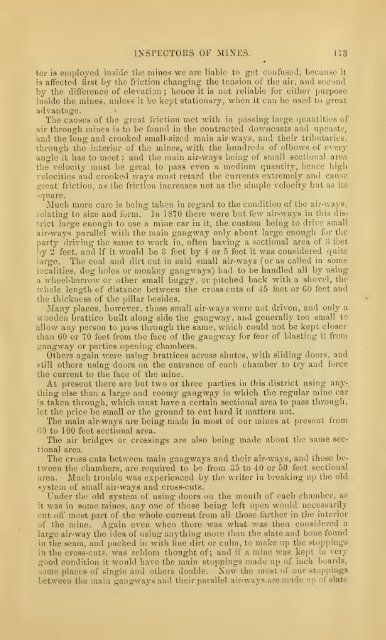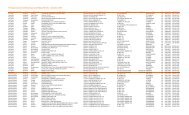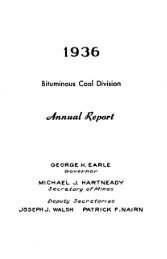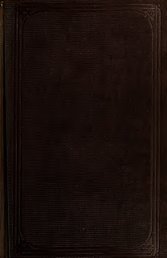Reports of the Inspectors of Mines of the anthracite coal regions of ...
Reports of the Inspectors of Mines of the anthracite coal regions of ...
Reports of the Inspectors of Mines of the anthracite coal regions of ...
Create successful ePaper yourself
Turn your PDF publications into a flip-book with our unique Google optimized e-Paper software.
INSPECTORS OF MINES. 1^3<br />
ter is employed inside <strong>the</strong> mines we are liable to get confnsed, because it<br />
is affected first by <strong>the</strong> friction changing- <strong>the</strong> tension <strong>of</strong> <strong>the</strong> air, and second<br />
by <strong>the</strong> dilference <strong>of</strong> elevation ; hence it is not reliable for ei<strong>the</strong>r purpose<br />
inside <strong>the</strong> mines, unless it be kept stationary, when it can be used to great<br />
advantage.<br />
The causes <strong>of</strong> <strong>the</strong> great friction met with in passing large (juantities <strong>of</strong><br />
air through mines is to be found in <strong>the</strong> contracted dov/ncasts and upcasts,<br />
and <strong>the</strong> long and crooked small-sized main air-ways, and <strong>the</strong>ir tributaries,<br />
through <strong>the</strong> interior <strong>of</strong> <strong>the</strong> mines, with <strong>the</strong> hundreds <strong>of</strong> elbows <strong>of</strong> every<br />
angle it has to meet ; and <strong>the</strong> main air-ways being <strong>of</strong> small sectional area<br />
<strong>the</strong> velocit}^ must be great to pass even a medium quantity, hence high<br />
velocities and crooked ways must retard <strong>the</strong> currents extremely and cause<br />
great friction, as <strong>the</strong> friction increases not as <strong>the</strong> simple velocity but as its<br />
square.<br />
Much more care is being taken in i-egard to <strong>the</strong> condition <strong>of</strong> <strong>the</strong> air-ways,<br />
relating to size and form. In 1870 <strong>the</strong>re were but few air-ways in this district<br />
large enough to use a mine car in it, <strong>the</strong> custom being to drive small<br />
air-wa3'S parallel with <strong>the</strong> main gangway only about large enough for <strong>the</strong><br />
party driving <strong>the</strong> same to work in, <strong>of</strong>ten having a sectional area <strong>of</strong> o feet<br />
by 2 feet, and if it would be 3 feet by 4 or 5 feet it was considered quite<br />
largo. The <strong>coal</strong> and dirt cut in said small air-ways (or as called in some<br />
localities, dog holes or monkey gangways) had to be handled all by using<br />
a wheel-barrow or o<strong>the</strong>r small buggy, or pitched back with a shovel, <strong>the</strong><br />
whole length <strong>of</strong> distance between <strong>the</strong> cross-cuts <strong>of</strong> 45 feet or 60 feet and<br />
<strong>the</strong> thickness <strong>of</strong> <strong>the</strong> pillar besides.<br />
Many places, however, those small air-ways were not driven, and only a<br />
wooden brattice built along side <strong>the</strong> gangway, and generally too small to<br />
allow any person to pass through <strong>the</strong> same, which could not be kept closer<br />
than 60 or 70 feet from <strong>the</strong> face <strong>of</strong> <strong>the</strong> gangway for fear <strong>of</strong> blasting it from<br />
gangway or parties opening chambers.<br />
O<strong>the</strong>rs again were using brattices across shutes, with sliding doors, and<br />
still o<strong>the</strong>rs using doors on <strong>the</strong> entrance <strong>of</strong> each chamber to try and force<br />
<strong>the</strong> cui'rent to <strong>the</strong> face <strong>of</strong> <strong>the</strong> mine.<br />
At present <strong>the</strong>re are but two or three parties in this district using anything<br />
else than a large and roomy gangway in which <strong>the</strong> regular mine car<br />
is taken through, which must have a certain sectional area to pass through,<br />
let <strong>the</strong> price be small or <strong>the</strong> ground to cut hard it matters not.<br />
The main air-ways are being made in most <strong>of</strong> our mines at present from<br />
60 to 100 feet sectional area.<br />
The air bridges or crossings are also being made about <strong>the</strong> same sectional<br />
area.<br />
The cross-cuts between main gangways and <strong>the</strong>ir air-ways, and those between<br />
<strong>the</strong> chambers, are required to be from 35 to 40 or 50 feet sectional<br />
area. Much trouble was experienced by <strong>the</strong> writer in breaking up <strong>the</strong> old<br />
system <strong>of</strong> small air- ways and cross-cuts.<br />
Under <strong>the</strong> old system <strong>of</strong> using doors on <strong>the</strong> mouth <strong>of</strong> each chamber, as<br />
it was in some mines, any one <strong>of</strong> those being left open would necessarily<br />
cut <strong>of</strong>f most part <strong>of</strong> <strong>the</strong> whole current from all those far<strong>the</strong>r in <strong>the</strong> interior<br />
<strong>of</strong> <strong>the</strong> mine. Again even when <strong>the</strong>re was what was <strong>the</strong>n considered a<br />
large air-waj^ <strong>the</strong> idea <strong>of</strong> using anything more than <strong>the</strong> slate and bone found<br />
in <strong>the</strong> seam, and packed in with fine dirt or culm, to make up <strong>the</strong> stoppings<br />
in <strong>the</strong> cross-cuts, was seldom thought <strong>of</strong>; and if a mine was kept iu ver3good<br />
condition it would have <strong>the</strong> main stoppings made up <strong>of</strong> inch boards,<br />
some places <strong>of</strong> single and o<strong>the</strong>rs double. Now <strong>the</strong> most <strong>of</strong> our stoppings<br />
between <strong>the</strong> main gangways and <strong>the</strong>ir parallel air-ways are made up <strong>of</strong> slate




![1945 Anthracite Annual Report Districts 19 - 25 [Adobe pdf - 9148Kb]](https://img.yumpu.com/50308099/1/190x119/1945-anthracite-annual-report-districts-19-25-adobe-pdf-9148kb.jpg?quality=85)


![1937 Anthracite Annual Report Districts 1 - 11 [Adobe pdf - 9394Kb]](https://img.yumpu.com/43539962/1/190x119/1937-anthracite-annual-report-districts-1-11-adobe-pdf-9394kb.jpg?quality=85)







![1931 Anthracite Annual Report Districts 1 - 11 [Adobe pdf - 8007Kb]](https://img.yumpu.com/39427789/1/190x119/1931-anthracite-annual-report-districts-1-11-adobe-pdf-8007kb.jpg?quality=85)

